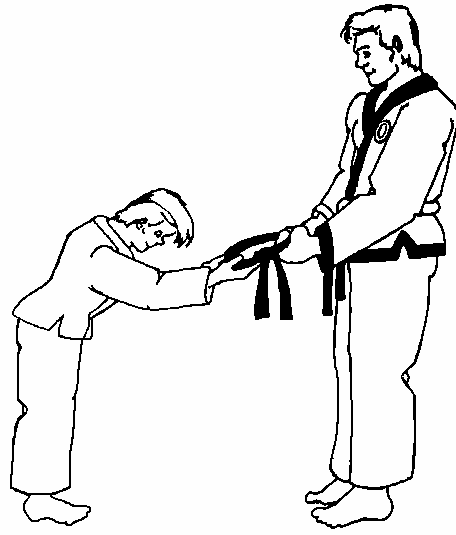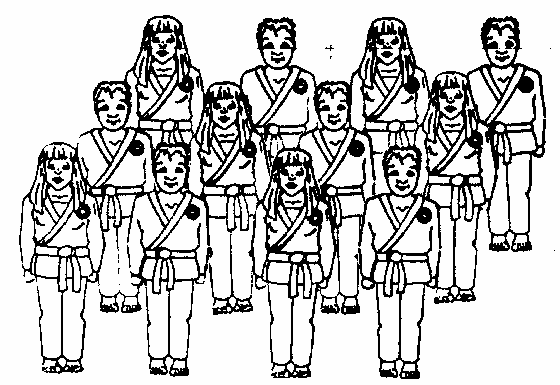
Traditional Korean Martial Arts
Welcome to
CARY MARTIAL ARTS, LLC.
50 years experience!
Soo Bahk Do Moo Duk Kwan
aka: Tang Soo Do Moo Duk Kwan
Martial Arts for the whole family!!!
MASTER DANIEL BANNARD IS CERTIFIED 8TH DEGREE
"There is only one Moo Duk Kwan!"

Welcome to the only certified Soo Bahk Do Moo Duk Kwan School in the Triangle Area!
Direct student of the late Founder KJN Hwang Kee,
and Present Grandmaster HC Hwang
MEMBER OF THE UNITED STATES SOO BAHK DO MOO DUK KWAN FEDERATION
PICTURES ARE PRECOVID

Soo Bahk Do Moo Duk Kwan
First it is important to understand that Soo Bahk Do is the Art and Moo Duk Kwan is the style. Soo Bahk Do is the technical side, and the Moo Duk Kwan is the philosophical side of "Soo Bahk Do Moo Duk Kwan." The name "Bahk" originated in the age of Chun Chu (2700 years ago) according to the Moo Yei Dobo Tong Ji, which is one of the oldest records of Korea's martial arts. Soo Bahk Do (combat with bare hands and feet) is the only Korean martial art handed down from the Ko Ku Ryo Dynasty, thereby making it the oldest Korean martial art (approx. 2,000 years old)
Translated literally, Moo Duk Kwan means "Institute of Martial Virtue." It is the scientific use of the body
in methods of self defense, combined with a strict philosophy guiding the practitioner towards discovering their full potential. Soo Bahk Do, translated means "Hand Striking Way", or the more esoteric translation: “Cultivation of the Individual” and is the means to forge a body towards gaining ultimate use of its faculties through intensive physical and mental training. It is an art of self defense and philosophy the secrets of which cannot be bought at any price other than serious and rigorous training. It is an art tempered on the lawns of Buddhist monasteries, against the steel of wandering bandits and on the fields of combat, its history is a long and honorable one.
What makes Soo Bahk Do different from other styles?
There are many fine styles of martial arts. Two of the many things that separate Soo Bahk Do from all other arts and make it unique, are its versatility and philosophy. Because ancient Korea was constantly attacked by both Japan and China, Soo Bahk Do became versatile out of necessity, the result being an art which demands mastery of the whole body, not just kicking

and punching. Challenging techniques ranging from quick and spontaneous movements to slow graceful flowing movements offer not only variety but also challenge everyone. Second, many styles teach effective self defense and fighting principles but Soo Bahk Do offers much more than just that. Learning fighting techniques without a strong philosophy is to burden society with more dangerous people. We use Soo Bahk Do to realize our full potential and emphasize "Virtue in action" demonstrating courage, discipline, confidence and humility through our sincere efforts in training and our behavior towards others. You won't just hear our philosophy you'll see it in action. THIS is what makes Soo Bahk Do VERY DIFFERENT! (www.soobahkdo.com)
Also, if one looks at how ‘business’ and the ‘Art’ of Soo Bahk Do Moo Duk Kwan weigh in, for us, the ‘Art’ is still more important. Many ‘Americanized’ styles have no system. They have no roots back to founding masters, nor to ancient origins. Their uniforms and belts are random color-combinations to add glitz and flash and appeal to the public. They often are a confusing compilation of pieces of different styles. Their websites will boast seven pages about the Master instructor and all of their personal accomplishments. Many random styles make promises that cannot be kept.
On the contrary, our team will emphasize the journey, not the resulting ‘Black Belt’ rank. We will emphasize character, not flashy technique. We will provide structure and excellence in instruction (along with corresponding books and videos) that have been passed on from generation to generation since ancient times. If you go to our website and the attached links to other studios, you will find very little about the instructors, but a lot about the Art we serve. We do not boast. Along with a single-style white uniform, we only carry the traditional belt colors of the seasons as we progress through the training stages. Even what is known as the ‘Black’ belt is in reality a ‘Midnight Blue’ belt in our style, to symbolize the idea of never quite reaching perfection (the color black). At ‘Midnight Blue’ the white uniform, or Do Bok, adds a midnight blue trim to represent the traditional, formal outfit of the warriors of the Ko Ku Ryo Dynasty. Our promotion to Master (red stripe inside midnight blue belt) involves a rigorous eight day boot camp, where character and poise under stress and sleep deprivation count just as much as effective technique.

What are the origins of Soo Bahk Do Moo Duk Kwan?
In Korea the indigenous arts of self defense (Soo Bahk Ki and Tae Kyun) we combined with other fighting principles (Northern and Southern Chinese Kung Fu) and moral guidelines such as the philosophy of Do (Tao), No Ja (Lao Tzu) and Kong Ja (Confucius) by Founder Grandmaster Hwang Kee, into what is now known as Soo Bahk Do (Tang Soo Do) Moo
Duk Kwan . This combination of techniques and philosophy resulted in the development of a form of self defense and mental conditioning unrivaled in the modern world.
Grandmaster and Founder Hwang Kee created the Moo Duk Kwan on November 9 1945. Grand Master Hwang Kee was first inspired to study the Martial arts in 1921 when he was about seven years old. At a traditional Festival called "Dan O" he was visiting a nearby village, where they had archery, wrestling and many other festivities. As Grand Master was enjoying the festival, a group of seven or eight men had a dispute with another man. Suddenly the group of men attacked the lone man, who began evading and counter attacking with his feet, eventually defeating the group of men. This ability to defend oneself against several attackers so impressed Grand Master Hwang Kee that at that moment he knew he wanted to learn the martial arts.
For several years Grand Master Hwang Kee studied and researched every available source, and at the age of 22 he was recognized as a Master among other martial artists. In May of 1935 Grand Master Hwang Kee began working for the Korean railroad company which allowed him to travel. In May of 1936 he met a Chinese Kung Fu master named Yang, Kuk Jin. Grand Master trained with Master Yang until 1946, at which time China was experiencing a communist revolution. The training consisted of Seh Bop (postures), Bo Bop (steps), Ryun Bop (conditioning) and Hyung (Forms) with their applications. November 9th 1945 Grandmaster Hwang Kee founded the Moo Duk Kwan. The basic ideal of the Moo Duk Kwan is the development of its participants. Strong individuals in Spirit and Body make strong communities, strong communities make strong nations, Strong and peaceful nations make a strong and peaceful world. Many branches of Tang Soo Do have broken off from the original Art; even Chuck Norris earned his Black Belt from the Founder and went off and started his own style. The unfortunate result of leaving the Founder’s Art is an unavoidable disconnect with the true Art and the adoption of an Americanized, commercialized, watered-down version that is then offered as a second-hand martial art to the public.
Since 2002 our Founder’s son H.C. Hwang has served as Kwan Jang Nim (Grand Master). He embodies the dreams and aspirations of his father as Soo Bahk Do Moo Duk Kwan continues to flourish all around the world. He has continued to carry on the legacy of the original martial art from 1945, and has promoted the dissemination of the Founder’s interpretation of the Moo Yei Dobo Tong Gi.
Want to learn more? Visit the National Website for great resources!

